南方医科大学神经病学2017年考博真题试卷
- 格式:pdf
- 大小:77.18 KB
- 文档页数:2
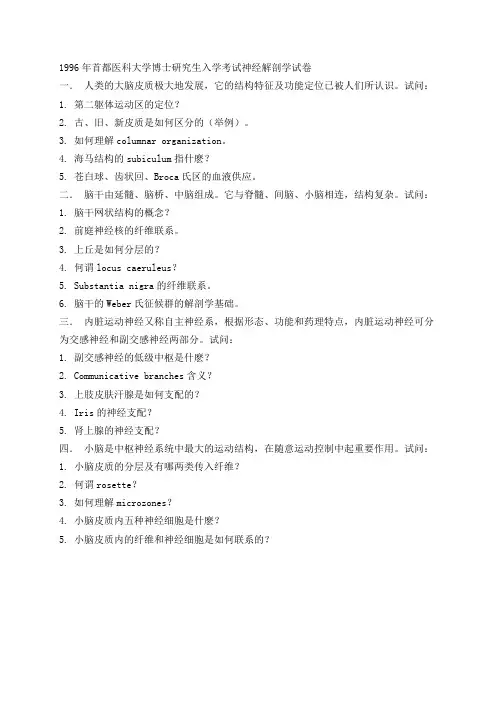
一.人类的大脑皮质极大地发展,它的结构特征及功能定位已被人们所认识。
试问:1. 第二躯体运动区的定位?2. 古、旧、新皮质是如何区分的(举例)。
3. 如何理解columnar organization。
4. 海马结构的subiculum指什麽?5. 苍白球、齿状回、Broca氏区的血液供应。
二.脑干由延髓、脑桥、中脑组成。
它与脊髓、间脑、小脑相连,结构复杂。
试问:1. 脑干网状结构的概念?2. 前庭神经核的纤维联系。
3. 上丘是如何分层的?4. 何谓locus caeruleus?5. Substantia nigra的纤维联系。
6. 脑干的Weber氏征候群的解剖学基础。
三.内脏运动神经又称自主神经系,根据形态、功能和药理特点,内脏运动神经可分为交感神经和副交感神经两部分。
试问:1. 副交感神经的低级中枢是什麽?2. Communicative branches含义?3. 上肢皮肤汗腺是如何支配的?4. Iris的神经支配?5. 肾上腺的神经支配?四.小脑是中枢神经系统中最大的运动结构,在随意运动控制中起重要作用。
试问:1. 小脑皮质的分层及有哪两类传入纤维?2. 何谓rosette?3. 如何理解microzones?4. 小脑皮质内五种神经细胞是什麽?5. 小脑皮质内的纤维和神经细胞是如何联系的?一.名词解释:1. 蓝斑2.海绵窦3.鼓索4.玫瑰结5.纹状体6.终纹6. 灰被 8.下托 9.边缘叶 10.翼腭神经节二.简述下列结构的神经支配及相关的起始核和终止核1. 肱桡肌2.梨状肌3.镫骨肌4.鱼际肌5.小指立毛肌6.竖脊肌7. 舌 8.泪腺 9.颈动脉窦 10.鼓膜张肌三.试述小脑皮质、大脑皮质的分层、结构特征及纤维联系?四.何谓上运动神经元?何谓下运动神经元?哪些部分的损伤可出现右下肢单瘫?五.综合分析中枢神经系是如何调控躯体运动的?同济1998博士试题一 1 west syndrome 2 transient global amnesia 3 argyll-robertosn's pupil4 lambert-eaton syndrome5 oculogyric-crisis二何谓脑分水岭梗塞?其常见病因及临床表现是什么?三试述肝豆状核变性的诊断依据和治疗措施四癫痫的诊断步骤和鉴别诊断五试述运动神经元病的常见类型及临床特点河北医科医大2001年神经病学试题一.周围神经疾病基本病理变化有几种?并加以说明二.简述蛛网膜下腔出血的症状,体征和治疗原则,并举出三种常见病因?三、重症肌无力发病原理?何谓肌无力危象及胆碱能危象?如发生上述两种危象如何处理?四、何谓脑膜刺激症?举出除脑膜炎症以外的三种疾病?五.简述桥脑小脑脚综合症临床表现?六、何谓闭锁综合症?七.上矢状窦血栓形成病因及临床表现?。

XXX2024临床医学综合2017年考博真题
试卷
XXX医学考博真题试卷攻读博士学位研究生入学考试试卷
XXX2017年攻读博士学位研究生入学考试试题
考试科目:2024临床医学综合注意:所有答案一律写在答题纸上,写在试题纸上或其他地方一律不给分。
一、简答题(7*10分=70分)
1、举例说明疾病发展因果交替的规律。
2、转化医学和精准医学的概念。
3、低钾对机体的影响。
4、呼酸对机体的影响及其机制。
5、失血性休克早期缺血的微循环特点及其代偿意义。
6、DIC概念及其发生发展的影响因素。
7、认知障碍的表现形式。
二、论述题(1*30分=30分)
结合个人领域写一个博士科研计划书。
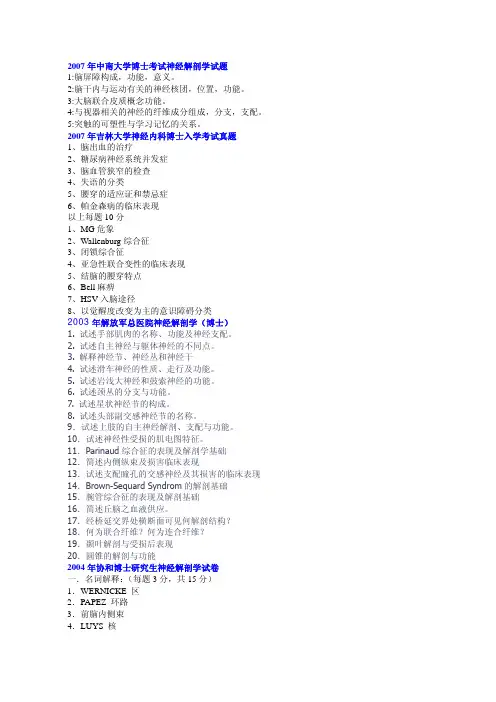
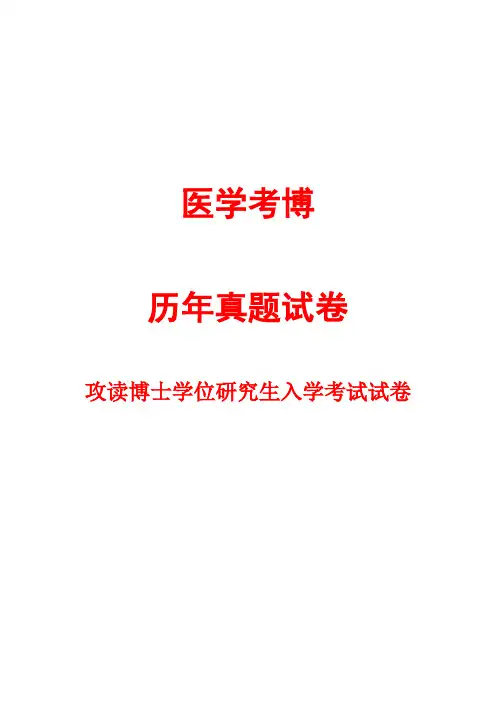

2017年医学博士外语真题试卷一(精选)(总分:126.00,做题时间:90分钟)1.Section A(分数:2.00)__________________________________________________________________________________________ 2.Rheumatologist advises that those with ongoing aches and pains first seek medical help to______ the problem.(分数:2.00)A.affiliateB.alleviateC.aggravateD.accelerate3.An allergy results when the body have a(n)______reaction to certain substances introduced to it.(分数:2.00)A.spontaneousB.negativeC.adverseD.prompt4.Diabetes is one of the most______and potentially dangerous diseases in the world.(分数:2.00)A.crucialB.virulentC.colossalD.prevalent5.Generally, vaccine makers______the virus in fertilized chicken eggs in a process that can take four to six months.(分数:2.00)A.penetrateB.designateC.generateD.exaggerate6.Drinking more water is good for the rest of your body, helping to lubricate jointsand______toxins and impurities.(分数:2.00)A.screen outB.knock outC.flush outD.rule out7.Despite their good service provided, most inns are less expensive than hotels of______standards.(分数:2.00)A.equivalentB.likelyC.alikeD.uniform8.Chronic high-dose intake of vitamin A has been shown to have______effects on bones.(分数:2.00)A.adverseB.prevalentC.instantD.purposeful9.According to the Geneva______no prisoners of war shall be subject to abuse.(分数:2.00)A.CustomsB.CongressesC.ConventionsD.Routines10.Environmental officials insist that something be done to______acid rain.(分数:2.00)A.curbB.sueC.detoxifyD.condemn11.It is impossible to say how it will take place, because it will happen______, and it will not be a long process.(分数:2.00)A.spontaneouslyB.simultaneouslyC.principallyD.approximately12.Section B(分数:2.00)__________________________________________________________________________________________13.The patient's condition has worsened since last night.(分数:2.00)A.improvedB.returnedC.deterioratedD.changed14.Beijing Television-Station Transmitting Tower really looks magnificent at night when it's lit up .(分数:2.00)A.decoratedB.illustratedC.illuminatedD.entertained15.Because of adverse weather conditions, the travelers stopped to camp.(分数:2.00)A.localB.unfamiliarC.goodD.unfavorablerm the manager if you are on medication that makes you drowsy .(分数:2.00)A.uneasyB.sleepyC.guiltyD.fiery17.The period from 3, 000 to 1, 000 B. C. E. , when the use of bronze became common , is normally referred to as the Bronze Age.(分数:2.00)A.obviousB.significantC.necessaryD.widespread18.Diabetes is one of the most prevalent and potentially dangerous diseases in the world.(分数:2.00)A.crucialB.virulentC.colossalD.widespread19.Likewise , soot and smoke from fire contain a multitude of carcinogens.(分数:2.00)A.a matter ofB.a body ofC.plenty ofD.sort of20.Many questions about estrogen's effects remain to be elucidated , and investigations are seeking answers through ongoing laboratory and clinical studies.(分数:2.00)A.implicatedB.impliedC.illuminatedD.initiated21.The defect occurs in the first eight weeks of pregnancy, though no one understands why.(分数:2.00)A.faultB.deviationC.discretionD.discrepancy22.The applications of genetic engineering are abundant and choosing one appropriate for this case can be rather difficult.(分数:2.00)A.sufficientB.plentifulC.adequateD.countable三、PartⅢ Cloze(总题数:1,分数:20.00)It was the kind of research that gave insight into how flu strains could mutate so quickly. (One theory behind the 1918 version's sudden demise after wreaking so much devastation was that it mutated to a nonlethal form. ) The same branch of research concluded in 2005 that the 1918 flu started in birds before passing to humans. Parsing this animal-human【C1】______could provide clues to【C2】______the next potential superflu, which already has a name: H5N1, also known as avian flu or bird flu. This potential killer also has a number: 59 percent. According to the World Health Organization, nearly three-fifths of the people who【C3】______H5N1 since 2003 died from the virus, which was first reported【C4】______humans in Hong Kong in 1997 before a more serious 【C5】______occurred in Southeast Asia between 2003 and 2004. (It has since spread to Africa and Europe. ) Some researchers argue that those mortality numbers are exaggerated because WHO only 【C6】______cases in which victims are sick enough to go to the hospital for treatment【C7】______compare that to the worldwide mortality rate of the 1918 pandemic; it may have killed roughly50 million people, but that was only 10 percent of the number of people infected, according toa 2006 estimate. H5N1's saving grace — and the only reason we're not running around masked up in public right now — is that the strain doesn't jump from birds to humans, or from humans to humans, easily. There have been just over 600 cases (and 359 deaths) since 2003. But【C8】______its lethality, and the chance it could turn into something far more transmissible, one might expect H5N1 research to be exploding, with labs【C9】______the virus's molecular components to understand how it spreads between animals and【C10】______to humans, and hoping to discover a vaccine that could head off a pandemic.(分数:20.00)(1).【C1】(分数:2.00)A.interactB.interfaceC.connectionD.contamination(2).【C2】(分数:2.00)A.stoppingB.stoppedC.have stoppedD.stop(3).【C3】(分数:2.00)A.contactedB.contractedC.concentratedD.infected(4).【C4】(分数:2.00)A.onB.inC.ofD.with(5).【C5】(分数:2.00)A.breakoutB.take placeC.happenD.outbreak(6).【C6】(分数:2.00)A.accountsB.numbersC.countsD.takes(7).【C7】(分数:2.00)A.MoreoverB.StillC.FurthermoreD.Thereafter(8).【C8】(分数:2.00)A.givenB.givingC.to giveD.speaking of(9).【C9】(分数:2.00)A.parsingB.parsedC.to parseD.having parsed(10).【C10】(分数:2.00)A.presentlyB.potentiallyC.potentlyD.importantly四、PartⅣ Reading Compre(总题数:6,分数:60.00)If you are reading this article, antibiotics have probably saved your life—and not once but several times. A rotten tooth, a knee operation, a brush with pneumonia; any number of minor infections that never turned nasty. You may not remember taking the pills, so unremarkable havethese one-time wonder drugs become. Modern medicine relies on antibiotics — not just to cure diseases, but to augment the success of surgery, childbirth and cancer treatments. Yet now health authorities are warning, in uncharacteristically apocalyptic terms, that the era of antibiotics is about to end. In some ways, bacteria are continually evolving to resist the drugs. But in the past we've always developed new ones that killed them again. Not this time. Infections that once succumbed to everyday antibiotics now require last-resort drugs with unpleasant side effects. Others have become so difficult to treat that they kill some 25, 000 Europeans yearly. And some bacteria now resist every known antibiotic. Regular readers will know why: New Scientist has reported warnings about this for years. We have misused antibiotics appallingly, handing them out to humans like medicinal candy and feeding them to livestock by the tonne, mostly not for health reasons but to make meat cheaper. Now antibiotic-resistant bacteria can be found all over the world — not just in medical facilities, but everywhere from muddy puddles in India to the snows of Antarctica (南极洲) . How did we reach this point without viable successors to today's increasingly ineffectual drugs? The answer lies not in evolution but economics. Over the past 20 years, nearly every major pharmaceutical company has abandoned antibiotics. Companies must make money, and there isn't much in short-term drugs that should be used sparingly. So researchers have discovered promising candidates, but can't reach into the deep pockets needed to develop them. This can be fixed. As we report this week, regulatory agencies, worried medical bodies and Big Pharma are finally hatching ways to remedy this market failure. Delinking profits from the volume of drug sold (by adjusting patent rights, say, or offering prizes for innovation) has worked for other drugs, and should work for antibiotics — although there may be a worryingly long wait before they reach the market. One day, though, these will fall to resistance too. Ultimately, we need, evolution-proof cures for bacterial infection: treatments that stop bacteria from causing disease, but don't otherwise inconvenience the little blighters. When resisting drugs confers no selective advantage, drugs will stop breeding resistance. Researchers have a couple of candidates for such treatment. But they fear regulators will drag their feet over such radical approaches. That, too, can be fixed. We must not neglect development of the sustainable medicine we need, the way we have neglected simple antibiotic R&D. If we do, one day another top doctor will be telling us that the drugs no longer work—and there really will be no help on the way.(分数:10.00)(1).In the first paragraph, the author is trying to______.(分数:2.00)A.warn us against the rampant abuse of antibiotics everywhereB.suggest a course of action to reduce antibiotic resistanceC.tell us a time race between humans and bacteriaD.remind us of the universal benefit of antibiotics(2).The warning from health authorities implies that______.(分数:2.00)A.the pre-antibiotic era will returnB.the antibiotic crisis is about to repeatC.the wonder drugs are a double-edged swordD.the development of new antibiotics is too slow(3).The appalling misuse of antibiotics, according to the passage, ______.(分数:2.00)A.has developed resistant bacteria worldwideB.has been mainly practiced for health reasonsC.has been seldom reported as a warning in the worldD.has been particularly worsened in the developing countries(4).The market failure refers to______.(分数:2.00)A.the inability to develop more powerful antibioticsB.the existing increasingly ineffectual drugs in the marketC.the poor management of the major pharmaceutical companiesD.the deprived investment in developing new classes of antibiotics(5).During the presentation of the two solutions, the author carries a tone of______.(分数:2.00)A.doubtB.urgencyC.indifferenceD.helplessnessWhere one stage of child development has been left out, or not sufficiently experienced, the child may have to go back and capture the experience of it. A good home makes this possible, for example by providing the opportunity for the child to play with a clockwork car or toy railway train up to any age if he still needs to do so. This principle, in fact, underlies all psychological treatment of children in difficulties with their development, and is the basis of work in child clinics. The beginnings of discipline are in the nursery. Even the youngest baby is taught by gradual stages to wait for food, to sleep and wake at regular intervals and so on. If the child feels the world around him is a warm and friendly one, he slowly accepts its rhythm and accustoms himself to conforming to its demands. Learning to wait for things, particularly for food, is a very important element in upbringing, and is achieved successfully only if too great demands are not made before the child can understand them. Every parent watches eagerly the child's acquisition of each new skill—the first spoken words, the first independent steps, or the beginning of reading and writing. It is often tempting to hurry the child beyond his natural learning rate, but this can set up dangerous feeling of failure and states of anxiety in the child. This might happen at any stage. A baby might be forced to use a toilet too early, a young child might be encouraged to learn to read before he knows the meaning of the words he reads. On the other hand, though, if a child is left alone too much, or without any learning opportunities, he loses his natural zest for life and his desire to find out new things for himself. Learning together is a fruit source of relationship between children and parents. By playing together, parents learn more about their children and children learn more from their parents. Toys and games which both parents and children can share are an important means of achieving this co-operation. Building-block toys, jigsaw puzzles and crossword are good examples. Parents vary greatly in their degree of strictness or indulgence towards their children. Some may be especially strict in money matters, others are severe over times of coming home at night, punctuality for meals or personal cleanliness. In general, the controls imposed represent the needs of the parents and the values of the community as much as the child's own happiness and well-being.(分数:10.00)(1).The principle underlying all treatment of developmental difficulties in children______.(分数:2.00)A.is to send them to clinicsB.offers recapture of earlier experiencesC.is in the provision of clockwork toys and trainsD.is to capture them before they are sufficiently experienced(2).The child in the nursery______.(分数:2.00)A.quickly learns to wait for foodB.doesn't initially sleep and wake at regular intervalsC.always accepts the rhythm of the world around themD.always feels the world around him is warm and friendly(3).The encouragement of children to achieve new skills______.(分数:2.00)A.can never be taken too farB.should be left to school teachersC.will always assist their developmentD.should be balanced between two extremes(4).Jigsaw puzzles are______.(分数:2.00)A.too difficult for childrenB.a kind of building-block toyC.not very entertaining for adultsD.suitable exercises for parent-child cooperation(5).Parental controls and discipline______.(分数:2.00)A.serve a dual purposeB.should be avoided as much as possibleC.reflect the values of the communityD.are designed to promote the child's happinessFor 150 years scientists have tried to determine the solar constant, the amount of solar energy that reaches the Earth. Yet, even in the most cloud-free regions of the planet, the solar constant cannot be measured precisely. Gas molecules and dust particles in the atmosphere absorb and scatter sunlight and prevent some wavelengths of the light from ever reaching the ground. With the advent of satellites, however, scientists have finally been able to measure the Sun's output without being impeded by the Earth's atmosphere. Solar Max, a satellite from the National Aeronautics and Space Administration (NASA), has been measuring the Sun's output since February 1980. Although a malfunction in the satellite's control system limited its observation for a few years, the satellite was repaired in orbit by astronauts from the space shuffle in 1984. Max's observations indicate that the solar constant is not really constant after all. The satellite's instruments have detected frequent, small variations in the Sun's energy output, generally amounting to no more than 0. 05 percent of the Sun's mean energy output and lasting from a few days to a few weeks. Scientists believe these fluctuations coincide with the appearance and disappearance of large groups of sunspots on the Sun's disk. Sunspots are relatively dark regions on the Sun's surface that have strong magnetic fields and a temperature about 2, 000 degrees Fahrenheit cooler than the rest of the Sun's surface. Particularly large fluctuations in the solar constant have coincided with sightings of large sunspot groups. In 1980, for example, Solar Max's instruments registered a 0. 3 percent drop in the solar energy reaching the Earth. At that time a sunspot group covered about 0. 6 percent of the solar disk, an area 20 times larger than the Earth's surface. Long-term variations in the solar constant are more difficult to determine. Although Solar Max's data have indicated a slow and steady decline in the Sun's output. Some scientists have thought that the satellite's aging detectors might have become less sensitive over the years, thus falsely indicating a drop in the solar constant. This possibility was dismissed, however, by comparing solar Max's observations with data from a similar instrument operating on NASA's Nimbus 7 weather satellite since 1978.(分数:10.00)(1).According to the passage, scientists believe variations in the solar constant are related to______.(分数:2.00)A.sunspot activityB.unusual weather patternsC.increased levels of dustD.fluctuations in the Earth's temperature(2).Why is it not possible to measure the solar constant accurately without a satellite?(分数:2.00)A.The Earth is too far from the Sun.B.Some areas on Earth receive more solar energy than others.C.There is not enough sunlight during the day.D.The Earth's atmosphere interferes with the sunlight.(3).Why did scientists think that Solar Max might be giving unreliable information?(分数:2.00)A.Solar Max did not work for the first few years.B.Solar Max's instruments were getting old.C.The space shuttle could not fix Solar Max's instruments.D.Nimbus 7 interfered with Solar Max's detectors.(4).The attempt to describe the solar constant can best be described as______.(分数:2.00)A.an ongoing research effortB.a question that can never be answeredC.an issue that has been resolvedD.historically interesting, but irrelevant to contemporary concerns(5).What does this passage mainly discuss?(分数:2.00)A.The components of the Earth's atmosphere,B.The launching of a weather satellite.C.The measurement of variations in the solar constant.D.The interaction of sunlight and air pollution.Optical illusions are like magic, thrilling us because of their capacity to reveal the fallibility of our senses. But there's more to them than that, according to Dr. Beau Lotto, who is wowing the scientific world with work that crosses the boundaries of art, neurology, natural history and philosophy. What they reveal, he says, is that the whole world is the creation of our brain. What we see, what we hear, feel and what we think we know is not a photographic reflection of the world, but an instantaneous unthinking calculation as to what is the most useful way of seeing the world. It's a best guess based on the past experience of the individual, a long evolutionary past that has shaped the structure of our brains. The world is literally shaped by our pasts. Dr. Lotto, 40, an American who is a reader in neuroscience at University College London, has set out to prove it in stunning visual illusions, sculptures and installations, which have been included in art-science exhibitions. He explains his complex ideas from the starting point of visual illusions, which far from revealing how fragile our senses are show how remarkably robust they are at providing a picture of the world that serves a purpose to us. For centuries, artists and scientists have noted that a grey dot looks lighter against a dark background than being against a light background. The conventional belief was that it was because of some way the brain and eye is intrinsically wired. But Dr. Lotto believes it's a learnt response; in other words, we see the world not as it is but as it is useful to us. "Context is everything, because our brains have evolved to constantly re-define normality, " says Dr. Lotto. "What we see is defined by our own experiences of the past, but also by what the human race has experienced through its history, " This is illustrated by the fact that different cultures and communities have different viewpoints of the world, conditioned over generations. For example, Japanese people have a famous inability to distinguish between the "R" and the "L" sound. This arises because in Japanese the sounds are totally interchangeable. "Differentiating between them has never been useful, so the brain has never learnt to do it. It's not just that Japanese people find it hard to tell the difference. They literally cannot hear the difference. " Dr. Lotto's experiments are grounding more and more hypotheses in hard science. "Yes, my work is idea-driven, " he says. "But lots of research, such as MRI brain scanning, is technique-driven. I don't believe you can understand the brain by taking it out of its natural environment and looking at it in a laboratory. You have to look at what it evolved to do, and look at it in relationship to its ecology. "(分数:10.00)(1).What does the word "them" in the first paragraph refer to?(分数:2.00)A.Human senses.B.The fallibility of senses.C.Revealing capacity.D.Optical illusions.(2).According to the passage, what is known about Dr. Beau Lotto?(分数:2.00)A.Though he is a neuroscientist, he has shocked the scientific world with his extensive research in art, neurology, natural history and philosophy.B.Dr. Lotto is a professor at University College London who is specialized in a number of disciplines such as art, neurology, natural history and philosophy.C.Dr. Lotto has been attempting to exhibit his creative productions in art-science exhibitions in the hope of proving his idea on optical illusions.D.Dr. Lotto has set out to create visual illusions, sculptures and installations which well combined the knowledge of art, neurology, natural history and philosophy.(3).Which of the following statements can be inferred from Dr. Lotto's study?(分数:2.00)A.People should believe their brains rather than their eyes as the world, to a great measure, is created and shaped by human brain.B.People should never believe their senses for what they see, hear, feel, and the truth may be contrary to the photographic image of the world.C.People should never believe their eyes for what they see are only accidental and temporary forms of the world, which varies in accordance with contexts.D.People should be aware that their eyes can play tricks on them as what they see is actually created by their brains which are shaped by their past experiences.(4).According to Dr. Lotto, what is the reason for the fact that a grey dot looks lighter againsta dark background than being against a light background?(分数:2.00)A.It is a fact that the dot emerged to be lighter against a dark background than being against a light one.B.Human senses are remarkably robust at providing a picture of the world that serves a purpose to us through what they have learnt from past experiences.C.It is because of some way the brain and eye is intrinsically wired.D.Because the context in which the little dot placed has changed to be lighter.(5).Which of the following statements is true about the research in neuroscience?(分数:2.00)A.Investigation on the brain involves scrutinizing a network in which both environment and the brain itself function together.B.Both idea-driven and technique-driven are popular research methods in research study in neuroscience.C.People cannot carry out research study on brain in laboratory where it is isolated from human body.D.Brain can be investigated in isolation with other faculties and organs as long as the research is carried out in proper natural context.The biggest thing in operating rooms these days is a million-dollar, multi-armed robot named da Vinci, used in nearly 400, 000 surgeries nationwide last year—triple the number just four years earlier. But now the high-tech helper is under scrutiny over reports of problems, including several deaths that may be linked with it and the high cost of using the robotic system. There also have been a few disturbing, freak incidents: a robotic hand that wouldn't let go of tissue grasped during surgery and a robotic arm hitting a patient in the face as she lay on the operating table. Is it time to curb the robot enthusiasm? Some doctors say yes, concerned that the "wow" factor and heavy marketing have boosted use. They argue that there is not enough robust research showing that robotic surgery is at least as good or better than conventional surgeries. Many U. S. hospitals promote robotic surgery in patient brochures, online and even on highway billboards. Their aim is partly to attract business that helps pay for the costly robot. The da Vinci is used for operations that include removing prostates, gallbladders and wombs, repairing heart valves, shrinking stomachs and transplanting organs. Its use has increased worldwide, but the system is most popular in the United States. For surgeons, who control the robot while sitting at a computer screen rather than standing over the patient, these operations can be less tiring. Plus robothands don't shake. Advocates say patients sometimes have less bleeding and often are sent home sooner than with conventional laparoscopic surgeries and operations involving large incisions. But the Food and Drug Administration is looking into a spike in reported problems during robotic surgeries. Earlier this year, the FDA began a survey of surgeons using the robotic system. The agency conducts such surveys of devices routinely, but FDA spokeswoman Synim Rivers said the reason for it now "is the increase in number of reports received" about da Vinci. Reports filed since early last year include at least five deaths. Whether there truly are more problems recently is uncertain. Rivers said she couldn't quantify the increase and that it may simply reflect more awareness among doctors and hospitals about the need to report problems. Doctors aren't required to report such things; device makers and hospitals are. Company spokesman Geoff Curtis said Intuitive Surgical has physician-educators and other trainers who teach surgeons how to use the robot. But they don't train them how to do specific procedures robotically, he said, and that it's up to hospitals and surgeons to decide "if and when a surgeon is ready to perform robotic cases. " A 2010 New England Journal of Medicine essay by a doctor and a health policy analyst said surgeons must do at least 150 procedures to become adept at using the robotic system. But there is no expert consensus on how much training is needed. New Jersey banker Alexis Grattan did a lot of online research before her gallbladder was removed last month at Hackensack University Medical Center. She said the surgeon's many years of experience with robotic operations was an important factor. She also had heard that the surgeon was among the first to do the robotic operation with just one small incision in the belly button, instead of four cuts in conventional keyhole surgery.(分数:10.00)(1).Why did FDA begin to scrutinize da Vinci?(分数:2.00)A.The number used in operation has been tripled.B.It is too expensive.C.It is reported to have frequent mechanical breakdown.wsuits increase with death case reports.(2).According to some doctors, which of the following is NOT the reason to curb the enthusiasm for da Vinci?(分数:2.00)A.The high cost causes unreasonable marketing.B.It is not as good as traditional surgeries.C.It needs more statistics to prove its value.D.It is necessary for doctors to consider some problems.(3).What does FDA spokeswoman Synim Rivers mean?(分数:2.00)A.Doctors and hospitals should be responsible for those problems.B.It is doctors that think da Vinci robots are problematic.C.There are so many problems reports that FDA has to do an enquiry.D.FDA hasn't finished the previous enquiry about the surgeons who used robots.(4).What is correct about training according to the Geoff Curtis?(分数:2.00)A.A lack of sufficient training on the part of surgeons.B.A lack of sufficient training on the part of company.C.Doctors and hospitals are not sufficiently trained on specific procedures.D.Doctors and hospitals are not sufficiently trained on how to used robots.(5).What is the best title for this passage?(分数:2.00)A.Four Hands Better than Two?B.Too Good to Be TrueC.Smart RobotsD.Who Is the Killer?Despite Denmark's manifest virtues, Danes never talk about how proud they are to be Danes. This would sound weird in Danish. When Danes talk to foreigners about Denmark, they always begin by。

首都医科大学神经病学专业历年考博试题回顾一.人类的大脑皮质极大地发展,它的结构特征及功能定位已被人们所认识。
试问:1.第二躯体运动区的定位?2.古、旧、新皮质是如何区分的(举例)。
3.如何理解columnar organization。
4.海马结构的subiculum指什麽?5.苍白球、齿状回、Broca氏区的血液供应。
二.脑干由延髓、脑桥、中脑组成。
它与脊髓、间脑、小脑相连,结构复杂。
试问:1.脑干网状结构的概念?2.前庭神经核的纤维联系。
3.上丘是如何分层的?4.何谓locus caeruleus?5.Substantia nigra的纤维联系。
6.脑干的Weber氏征候群的解剖学基础。
三.内脏运动神经又称自主神经系,根据形态、功能和药理特点,内脏运动神经可分为交感神经和副交感神经两部分。
试问:1.副交感神经的低级中枢是什麽?municative branches含义?3.上肢皮肤汗腺是如何支配的?4.Iris的神经支配?5.肾上腺的神经支配?四.小脑是中枢神经系统中最大的运动结构,在随意运动控制中起重要作用。
试问:(PS:The way to contact yumingkaobo TEL:si ling ling-liu liu ba-liu jiu qi ba QQ:772678537)1.小脑皮质的分层及有哪两类传入纤维?2.何谓rosette?3.如何理解microzones?4.小脑皮质内五种神经细胞是什麽?5.小脑皮质内的纤维和神经细胞是如何联系的?一.名词解释:1.蓝斑2.海绵窦3.鼓索4.玫瑰结5.纹状体6.终纹6.灰被8.下托9.边缘叶10.翼腭神经节二.简述下列结构的神经支配及相关的起始核和终止核1.肱桡肌2.梨状肌3.镫骨肌4.鱼际肌5.小指立毛肌6.竖脊肌7.舌8.泪腺9.颈动脉窦10.鼓膜张肌三.试述小脑皮质、大脑皮质的分层、结构特征及纤维联系?四.何谓上运动神经元?何谓下运动神经元?哪些部分的损伤可出现右下肢单瘫?五.综合分析中枢神经系是如何调控躯体运动的?二何谓脑分水岭梗塞?其常见病因及临床表现是什么?三试述肝豆状核变性的诊断依据和治疗措施四癫痫的诊断步骤和鉴别诊断五试述运动神经元病的常见类型及临床特点一.周围神经疾病基本病理变化有几种?并加以说明二.简述蛛网膜下腔出血的症状,体征和治疗原则,并举出三种常见病因?三、重症肌无力发病原理?何谓肌无力危象及胆碱能危象?如发生上述两种危象如何处理?四、何谓脑膜刺激症?举出除脑膜炎症以外的三种疾病?五.简述桥脑小脑脚综合症临床表现?六、何谓闭锁综合症?七.上矢状窦血栓形成病因及临床表现?本文由“育明考博”整理编辑。
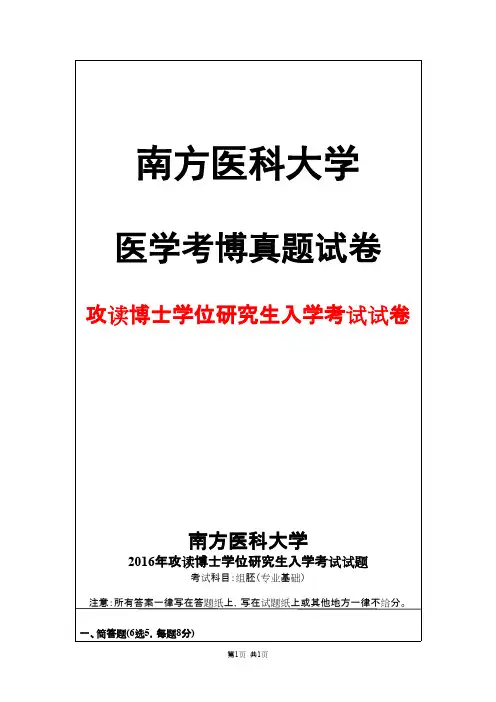
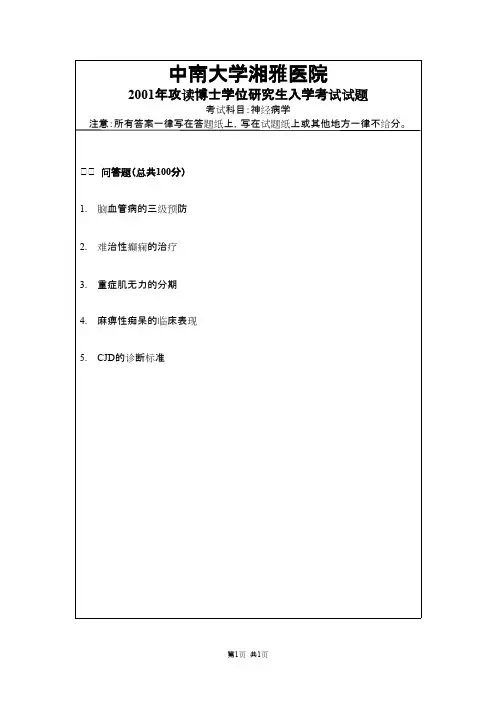
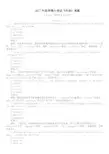
2017年医学博士考试《外语》真题(总分100, 考试时间90分钟)Section A1. Rheumatologist advises that those with ongoing aches and pains first seek medical help to______ the problem.A affiliateB alleviateC aggravateD accelerate答案:B解析:风湿病学家建议,那些持续疼痛和痛苦的人首先应该借助医疗来缓解问题。
affiliate"接纳,为……工作",alleviate"减少,减缓",aggravate"增加",accelerate"加速"。
根据题意,正确答案为B。
2. An allergy results when the body have a(n)______reaction to certain substances introduced to it.A spontaneousB negativeC adverseD prompt答案:C解析:当身体对某种外来物质产生不良反应时,就会出现过敏现象。
spontaneous"同时的",negative"负面的",adverse"不利的",prompt"立刻的"。
在有关过敏的语境里,一般"不良反应"用an adverse reaction,而不用negative,正确答案为C。
3. Diabetes is one of the most______and potentially dangerous diseases in the world.A crucialB virulentC colossalD prevalent答案:D解析:糖尿病是世界上最普遍的潜在危险疾病之一。
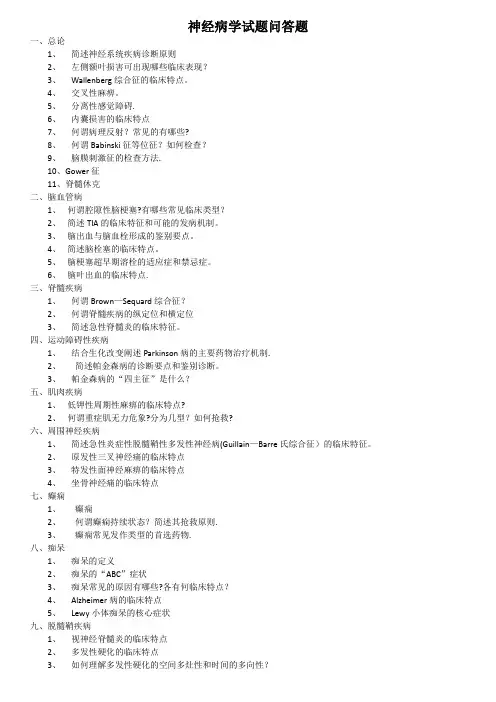
神经病学试题问答题一、总论1、简述神经系统疾病诊断原则2、左侧额叶损害可出现哪些临床表现?3、Wallenberg综合征的临床特点。
4、交叉性麻痹。
5、分离性感觉障碍.6、内囊损害的临床特点7、何谓病理反射?常见的有哪些?8、何谓Babinski征等位征?如何检查?9、脑膜刺激征的检查方法.10、Gower征11、脊髓休克二、脑血管病1、何谓腔隙性脑梗塞?有哪些常见临床类型?2、简述TIA的临床特征和可能的发病机制。
3、脑出血与脑血栓形成的鉴别要点。
4、简述脑栓塞的临床特点。
5、脑梗塞超早期溶栓的适应症和禁忌症。
6、脑叶出血的临床特点.三、脊髓疾病1、何谓Brown—Sequard综合征?2、何谓脊髓疾病的纵定位和横定位3、简述急性脊髓炎的临床特征。
四、运动障碍性疾病1、结合生化改变阐述Parkinson病的主要药物治疗机制.2、简述帕金森病的诊断要点和鉴别诊断。
3、帕金森病的“四主征”是什么?五、肌肉疾病1、低钾性周期性麻痹的临床特点?2、何谓重症肌无力危象?分为几型?如何抢救?六、周围神经疾病1、简述急性炎症性脱髓鞘性多发性神经病(Guillain—Barre氏综合征)的临床特征。
2、原发性三叉神经痛的临床特点3、特发性面神经麻痹的临床特点4、坐骨神经痛的临床特点七、癫痫1、癫痫2、何谓癫痫持续状态?简述其抢救原则.3、癫痫常见发作类型的首选药物.八、痴呆1、痴呆的定义2、痴呆的“ABC”症状3、痴呆常见的原因有哪些?各有何临床特点?4、Alzheimer病的临床特点5、Lewy小体痴呆的核心症状九、脱髓鞘疾病1、视神经脊髓炎的临床特点2、多发性硬化的临床特点3、如何理解多发性硬化的空间多灶性和时间的多向性?神经病学考试题库(一)一、填空(总分20分,每空1分)1、一般感觉包括________、________、________.2、头不能向左侧偏以对杭检查者的阻力是________侧________肌瘫痪。
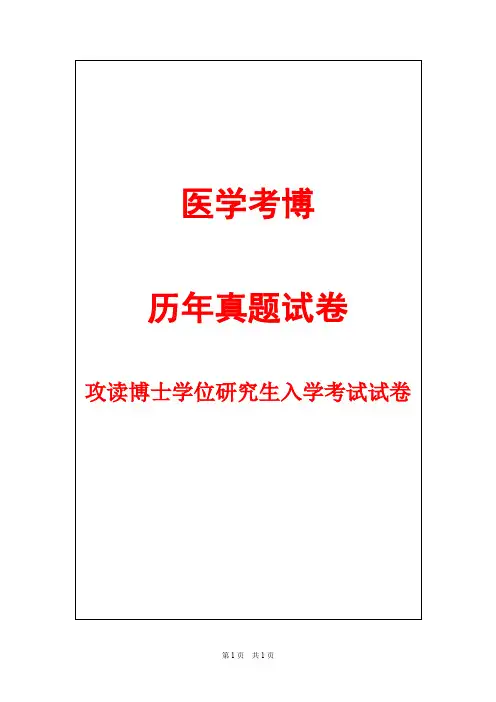
一旦作弊,取消学位┏━━━━━━━━━━━┓┏━━━━━━━━┓┃注意∶考号必须认真填写┃┃试卷密号∶200501┃┃否则无效. ┃┃┃┗━━━━━━━━━━━┛┗━━━━━━━━┛============================================================================临床医学专业年级本科生精神神经病学期末考试试卷(A)┏━━━━━━━━━━━━━━━━━━━━━━━━━━━━━━━━━━━━┓┃┃┃考试日期∶2009.01.10 ┃答卷时间∶2 小时负责人∶┃┃┃┠───┬──┬──┬──┬──┬──┬──┬──┬──┬──┬──┬──┨┃题型│一│二│三│四│五│六│七│八│九│十│合计┃┠───┼──┼──┼──┼──┼──┼──┼──┼──┼──┼──┼──┨┃满分│││││││││││0 ┃┠───┼──┼──┼──┼──┼──┼──┼──┼──┼──┼──┼──┨┃得分│││││││││││┃┠───┼──┼──┼──┼──┼──┼──┼──┼──┼──┼──┼──┨┃评│││││││││││┃┃卷│││││││││││┃┃人│││││││││││┃┗━━━┷━━┷━━┷━━┷━━┷━━┷━━┷━━┷━━┷━━┷━━┷━━┛考号∶---------------部别∶---------------姓名∶---------------神经内科教研室2009年1月10日印第1页----------------------------------------------------------------------------一、A型题┌──────────────────────────┐│每道题下面均有A、B、C、D、E五个备选答案,答题││时只许从中选择一个最合适的答案,并在答题卡上将相应││的字母涂黑,以示正确回答。
│└──────────────────────────┘1. 在听觉传导中,下述哪项不正确? BA.听觉传导由三级神经元组成B.第一级神经元胞体位于螺旋神经节C.第二级纤维形成斜方体D.第三级神经元胞体位于外侧膝状体E.听觉内中枢在颞横回前部2. 哪种情况可出现单侧瞳孔扩大? BA.视乳头水肿B.后交通动脉起始部动脉瘤C.延髓出血D.安眠药中毒E.农药中毒3. 对嗅神经的检查常选择下列哪种物质? CA.醋酸B.清凉油C.香皂D.氨水E.薄荷4. 女,24岁。
南方医科大学人体解剖学真题简答题:1、肩关节的构成,结构特点和运动方式由肱骨头与肩胛骨关节盂构成,也称盂肱关节,属球窝关节。
其结构特点是:肱骨头大,关节盂浅而小,关节盂周缘有盂唇来加深关节窝,但仍仅能容纳关节头的1/4-l/3。
关节囊薄而松弛。
关节囊的上壁有喙肱韧带,连于喙突至肱骨大结节之间,囊的前壁和后壁也有许多肌腱加入,以增加关节的稳固性。
囊的下壁相对最为薄弱.故肩关节脱位时,肱骨头容易发生前下方脱位。
肱二头肌长头腱穿过关节腔。
肩关节为全身运动最灵活的关节,可作屈和伸,收和展,旋内和旋外运动以及环转运动(三轴运动).臂外展超过40—60°,继续抬高至180°时,常伴随胸锁、肩锁关节的运动及肩胛骨的旋转运动2、甲状腺手术切口的层次关系问:甲状腺手术入路经过哪些层次?这些层次有哪些形态特点?(复旦)如果甲状腺肿大能影响哪些局部器官? (复旦)经过的层次:皮肤——浅筋膜(含颈阔肌)—-封套筋膜-—舌骨下肌群(胸骨舌骨肌—-胸骨甲状肌)——气管前筋膜-—甲状腺真被膜——甲状腺实质。
毗邻:左右两侧叶的后内侧临近喉与气管,咽与食管以及喉返神经,侧叶的后外侧与颈动脉鞘及颈交感干相邻,甲状腺侧叶后面有两对扁圆形的甲状旁腺。
当甲状腺肿大时,如向后压迫,可出现呼吸、吞咽困难和声音嘶哑:如向后外方压迫交感干时.可出现Horner综合征,即瞳孔缩小、眼裂变窄(上睑下垂)及眼球内陷等。
侧叶的后内侧与喉和气管、咽和食管以及喉返神经等相邻;侧叶的后外侧与颈动脉鞘及鞘内的颈总动脉、颈内静脉和迷走神经,以及位于椎前筋膜深面的颈交感干相邻。
3、子宫的形态,分部和固定装置问:子宫的位置,形态,分部,动、静脉来源、淋巴回流?(华西2001)试述子宫的形态、位置、姿势和固定装置。
(华西2002、2003)位置:子宫位于盆腔中部,前为膀胱,后为直肠,两侧有输卵管、卵巢及子宫阔韧带,下接阴道.成年正常女性子宫为前倾前屈位。
华中科技大学、吉林大学、暨南大学、南方医科大学、南京医科大学七、华中科技大学2017 年华中科技大学神经内科复试真题(一)学硕 A 卷1.名词解释(全英文)(1)无动性缄默症(2)Weber 综合征(3)Locked-in syndrome(4)Hunt syndrome(5)Horner Syndrome2.简答题(1)分水岭脑梗死的类型和临床表现(2)线粒体脑肌病的临床表现(3)帕金森病的药物治疗(4)重症肌无力危象的表现和处理原则(5)脊髓髓内病变、髓外硬膜内病变和硬膜外病变的鉴别诊断(二)学硕 B 卷1.名词解释(全英文)(1)核间性眼肌麻痹(2)weber 综合症(3)脊髓半切综合症(4)闭锁综合症(5)周期性麻痹2.简答题(1)线粒体脑肌病的临床表现(2)脊髓横贯性损伤的临床表现(3)癫痫持续状态及处理(4)重症肌无力危象及处理原则(5)帕金森药物治疗(三)专硕1.名词解释(1)Delirium(2)Hoffman sign(3)Syncope(4)Vertigo(5)dyspnea2.简答题(1)常见脑、脑膜疾病的脑脊液特点(2)简述头痛的发生机制和常见原因(3)简述癫痫持续状态的定义和处理(4)如何鉴别中枢性面瘫与周围性面瘫(5)如何通过神经反射定位脊髓损伤八、吉林大学(一)名词解释lard Gubler 综合症2.一个半综合症3.Willis 环4.运动性失语(二)简答题1.动眼神经麻痹的临床表现2.感觉性失语的表现及损失部位3.格林巴利综合征的诊断要点4.何谓视神经性脊髓炎5.急性脊髓炎的临床表现6.急性四肢瘫痪的常见原因及鉴别7.急性炎症性脱髓鞘性多发性神经炎的临床表现8.脊髓半离断的主要临床表现9.脊髓背外侧综合征10.壳核出血的临床表现11.六级肌力记录法12.脑桥出血临床表现13.帕金森病的临床表现14.偏头痛的临床分类15.三叉神经痛的临床表现16.三种肌无力危象的鉴别17.上下运动元瘫痪的鉴别18.延髓背外侧综合征的表现19.腰穿的禁忌症和适应证20.意识障碍的程度分级21.运动性感觉失语和感觉性失语部位及临床表现22.运动性失语的病变部位和主要表现23.真性球麻痹和假性球麻痹的鉴别24.震颤麻痹的主要临床特点25.中枢面神经麻痹和周围面神经麻痹的鉴别26.重症肌无力危象的分类27.蛛网膜下腔出血的并发症(三)论述题1.病毒性、化脓性、结核性脑膜炎2017 年吉林大学第一医院神经内科复试真题(一)简答题1.癫痫失神发作的临床特点2.跌倒发作的临床特点3.动眼神经麻痹的临床特点4.急性脊髓横贯性损伤的临床表现5.壳核出血的临床表现6.命名性失语的概念及病变部位7.帕金森病的临床特点8.三叉神经痛的临床表现9.什么叫分离性感觉障碍举一个常见的例子。